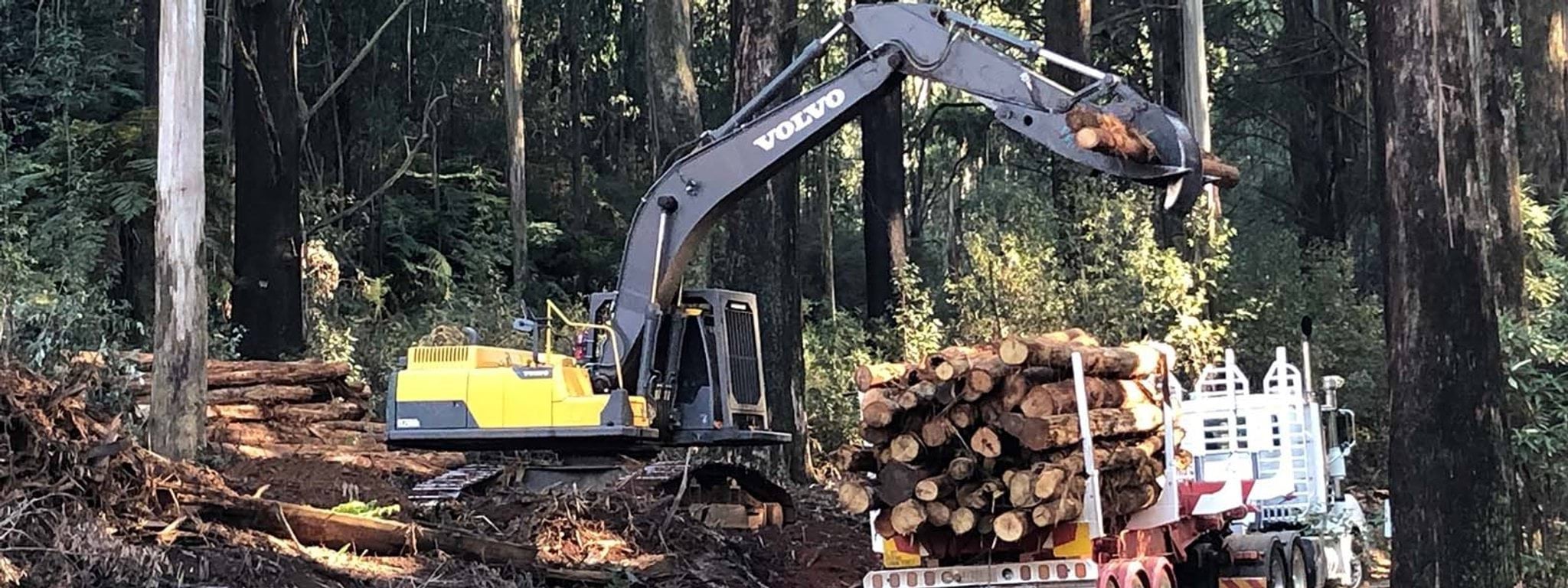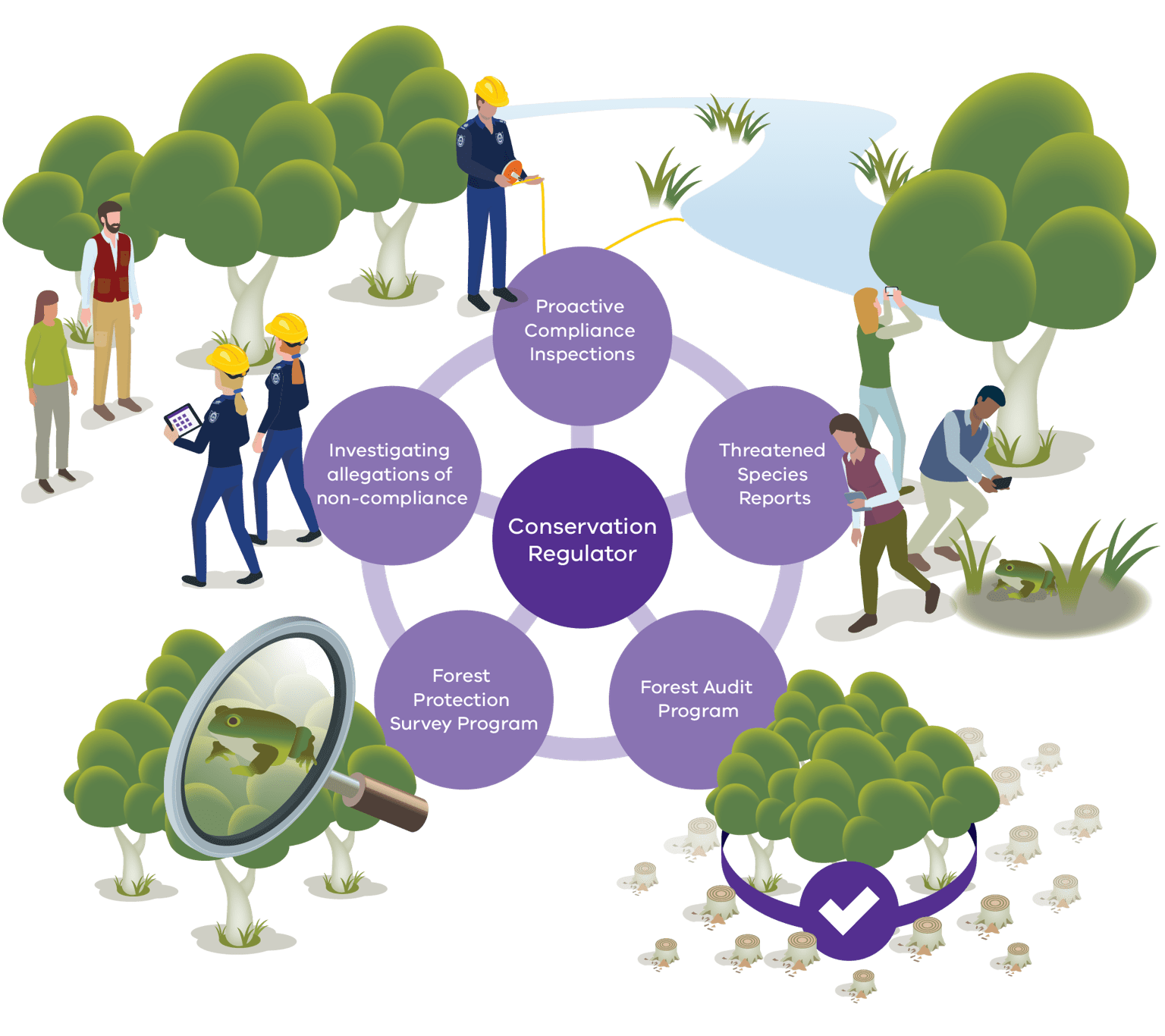Timber harvesting continues to be a key focus for the Conservation Regulator.
A holistic approach to timber harvesting regulation
The Conservation Regulator undertakes a number of activities to monitor compliance with timber harvesting regulations.
We have an integrated approach to the identification and protection of forest values, and ensure that timber harvesting complies with environmental law (see Figure 4 below).
Under this approach, we undertake a range of proactive activities along with audits and assess all allegations of non-compliance. When non-compliance is identified, we take proportionate enforcement action.
Proactive coupe inspections
The Proactive Coupe Inspection Program focuses on preventing environmental harm during timber harvesting. The coupes we inspect are selected based on the presence of important environmental values and high-risk activities.
Information such as threatened species surveys, third-party reports, independent audits and our officer observations are integral when prioritising coupes for inspection.
Inspections may occur before, during or after timber harvesting, and sometimes across the entire harvesting cycle.
In 2020-21, we inspected 58 coupes, exceeding the target of 30 per annum.
We have found that an active and growing field presence prevents harm and means that issues can be resolved before they impact on environmental values or become more serious issues of non‑compliance.
Prior to this program, Conservation Regulator was largely reactive and reliant on third party reports to drive our compliance effort. While third party information remains important to the Conservation Regulator, we now have a proactive approach to prioritising our compliance effort and generating our own intelligence.
Reports of non-compliance and threatened species detections
The Conservation Regulator receives reports from the community about allegations of non-compliant timber harvesting activities, as well as reports of threatened species in, or adjacent to, locations where timber harvesting is planned.
All allegations are assessed by experienced Authorised Officers in accordance with case management principles and protocols.
While threatened species verification occurs, the Conservation Regulator ensures interim protections are applied to protect values from timber harvesting.
In 2020–21, we received 62 reports of alleged non-compliance compared to 30 in 2019–20.
With respect to threatened species reports, we received 70 in 2020–21, compared to 74 in 2019–20.
Overall in 2020–21 we processed and closed 151 threatened species reports. The majority (111) of these closures were historic reports of Greater Glider detections. A total of 45 threatened species reports remain while they are verified.
Over the financial year, we issued three letters of advice, three formal written warnings and one direction for remediation regarding timber harvesting activities.
As at end of the financial year, two allegations of non‑compliance are currently the subject of preliminary assessments, while six formal investigations are ongoing.
Forest Protection Survey Program
Our Forest Protection Survey Program (FPSP) aims to detect conservation values such as animals and plants and their habitats that are either threatened or of high conservation value in areas of state forest that are scheduled to be harvested.
The program has an annual target of surveying 80 per cent of coupes before timber harvesting takes place. In 2020–21, we significantly exceeded this target and conducted 940 surveys on 384 coupes (94%) planned for timber harvesting.
The FPSP is contributing to better conservation outcomes at the species and ecosystem level.
In some cases, the FPSP results have developed in coupes no longer being considered for any harvest due to the high number of values requiring protection being found by the program.
This data and information are critical in providing improved protections for many species and other values. Detections from the FPSP have also contributed directly to the Zoos Victoria Giant Burrowing Frog breeding program.
The outcomes of all FPSP reports detections to the public via the FPSP website, the Forest Information Portal, and directly to VicForests.
Forest Audit Program
The Forest Audit Program (FAP) assesses the compliance of VicForests’ timber harvesting operations with the requirements outlined in the Code of Practice for Timber Production 2014 (the Code) and the Management Standards and Procedures for Timber Harvesting Operations in Victoria’s State Forests 2014 (MSPs).
Each year, we commission an independent environmental audit to measure compliance of commercial timber harvesting operations against the requirements set out in the Code.
A representative sample of coupes harvested in the 2019–20 financial year was targeted, based upon the presence of ‘high-risk’ features or factors (such as the presence of rainforest, waterway crossings, steep slopes, or threatened species).
Risk-based auditing ensures sound, cost-effective assessment of timber harvesting practices in areas of State Forest where the risks and associated impacts are comparatively greater.
The 2020–21, FAP focused on the following key themes:
- Protection of soil, water, and biodiversity values
- Execution of in-coupe road design and construction
- Implementation of forest coupe planning
- Timber harvesting activities in the 2019–20 fire footprint for East Gippsland, Tambo, and North East Forest Management Areas.
The findings from these audits are used to improve operational practices and inform improvements to the regulatory framework.
The published audit reports, alongside formal responses to the auditor’s recommendations from both VicForests and DELWP enhance the transparency of Victoria’s forest management arrangements.
Taking a precautionary approach
The precautionary principle is a clause within the Code and is an important part of Victoria’s regulations for timber harvesting.
Where there is a risk that timber harvesting operations may cause serious or irreversible damage to the environment and uncertainty as to that risk, the native timber harvesting industry must put controls in place to minimise that risk.
Following the devastating 2019–20 bushfires, the Conservation Regulator engaged with the timber harvesting industry to ensure they understood their legal obligation to apply the precautionary principle.
This is an ongoing process and one that has already resulted in changes to the way the timber industry operates including temporary exclusions on timber harvesting in burnt and unburnt areas of East Gippsland and additional protections to ensure impacts of timber harvesting are minimised to species of most concern and during salvage operations.
Victorian Forestry Plan
In 2019, the Victorian Government announced the Victorian Forestry Plan which commits to a gradual phaseout of all logging in native forests by 2030 and an immediate end to logging of old-growth forests.
The Conservation Regulator monitors and publicly reports on VicForests’ compliance with the government’s policy to end timber harvesting of old-growth forests.
To support compliance with the new government policy ahead of it becoming law, we developed guidance for consistent identification and protection of old-growth forests, and the survey methods and data requirements for submitting third-party reports of Greater Gliders.
The final procedure was developed into two companion documents, an Assessment Tool and Regulatory Guide, which were released in 2020.
Independent Review into Timber Harvesting Regulation
In September 2018, the Secretary of DELWP commissioned the Independent Review into Timber Harvesting Regulation 2018 (Review), at the request of the Minister for Energy, Environment and Climate Change, the Hon Lily D’Ambrosio.
DELWP accepted all recommendations in full and made further commitments in response to the Review.
Significant progress has been made towards the implementation of the commitments with the final two actions from the review due for completion in 2021–22. The recommendations Conservation Regulator is responsible for are summarised in Appendix A.
| Performance Measure | Target | Result | Comment |
|---|---|---|---|
|
Per cent of coupes planned for timber harvesting that have assessments under the FPSP for the potential presence of target flora and fauna, including threatened species and other values such as prescribed vegetation communities and trees |
100% |
100% |
Target met |
|
Per cent of coupes planned for harvest that are surveyed |
80% |
94% |
The current result reflects that surveys must be conducted well ahead of harvest period to ensure results can be incorporated into planning early. $1m was brought forward to the 2020-21 financial year to enable the FPSP to get ahead of VicForests harvest schedule. |
|
Per cent of coupes identified to contain rainforest as part of the FPSP that are spot checked |
20% |
NA |
Checks of rainforest are now embedded within the Proactive Coupe Inspection Program, and it is an important value that is considered when selecting coupes for assessment. |
|
Acknowledge receipt of reports of non-compliance |
<2 work days |
0.47 work days |
Target met |
|
Commence the verification of threatened species reports |
<5 work days |
1.36 work days |
Target met |
|
Number of coupes harvested in previous year that were audited as part of the FAP |
30 |
30 |
Target met |
|
Number of coupes planned for timber harvesting, or where timber harvesting is underway, that are subject to compliance inspections |
30 |
58 |
In 2020–21, the Proactive Coupe Inspection Program became the priority focus in regulating timber harvesting. This focus on preventing environmental harm or its continuation underpins our exceedance of our target this financial year. Conservation Regulator is committed to prioritising proactive coupe inspections, which prevent environmental harm or the continuation thereof |
|
Average time taken to investigate alleged or suspected non‑compliance |
<12 months |
15.7 months |
The number of allegations of non-compliance for 2020–21 was more than twice that of the prior year (62 in total), which has led to delays in completing investigations |
| Activity measure | Result |
|---|---|
|
Number of threatened species reports received |
70 |
|
Number of threatened species reports that underwent verification |
28 |
|
Number of reports of alleged or suspected non‑compliance received |
62 |
|
Number of reports of alleged or suspected non‑compliance investigated |
4 |
Updated

